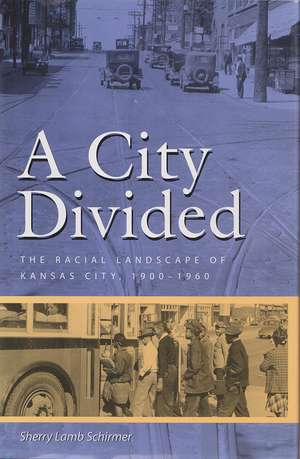A City Divided: The Racial Landscape of Kansas City, 1900-1960
Autor Sherry Lamb Schirmeren Limba Engleză Paperback – 30 iul 2016 – vârsta ani
A City Divided traces the development of white Kansas Citians’ perceptions of race and examines the ways in which those perceptions shaped both the physical landscape of the city and the manner in which Kansas City was policed and governed. Because of rapid changes in land use and difficulties in suppressing crime and vice in Kansas City, the control of urban spaces became an acute concern, particularly for the white middle class, before race became a problematic issue in Kansas City.
As the African American population grew in size and assertiveness, whites increasingly identified blacks with those factors that most deprived a given space of its middle-class character. Consequently, African Americans came to represent the antithesis of middle-class values, and the white middle class established its identity by excluding blacks from the urban spaces it occupied.
By 1930, racial discrimination rested firmly on gender and family values as well as class. Inequitable law enforcement in the ghetto increased criminal activity, both real and perceived, within the African American community. White Kansas Citians maintained this system of racial exclusion and denigration in part by “misdirection,” either by denying that exclusion existed or by claiming that segregation was necessary to prevent racial violence. Consequently, African American organizations sought to counter misdirection tactics. The most effective of these efforts followed World War II, when local black activists devised demonstration strategies that targeted misdirection specifically.
At the same time, a new perception emerged among white liberals about the role of race in shaping society. Whites in the local civil rights movement acted upon the belief that integration would produce a better society by transforming human character. Successful in laying the foundation for desegregating public accommodations in Kansas City, black and white activists nonetheless failed to dismantle the systems of spatial exclusion and inequitable law enforcement or to eradicate the racial ideologies that underlay those systems.
These racial perceptions continue to shape race relations in Kansas City and elsewhere. This study demystifies these perceptions by exploring their historical context. While there have been many studies of the emergence of ghettos in northern and border cities, and others of race, gender, segregation, and the origins of white ideologies, A City Divided is the first to address these topics in the context of a dynamic, urban society in the Midwest.
As the African American population grew in size and assertiveness, whites increasingly identified blacks with those factors that most deprived a given space of its middle-class character. Consequently, African Americans came to represent the antithesis of middle-class values, and the white middle class established its identity by excluding blacks from the urban spaces it occupied.
By 1930, racial discrimination rested firmly on gender and family values as well as class. Inequitable law enforcement in the ghetto increased criminal activity, both real and perceived, within the African American community. White Kansas Citians maintained this system of racial exclusion and denigration in part by “misdirection,” either by denying that exclusion existed or by claiming that segregation was necessary to prevent racial violence. Consequently, African American organizations sought to counter misdirection tactics. The most effective of these efforts followed World War II, when local black activists devised demonstration strategies that targeted misdirection specifically.
At the same time, a new perception emerged among white liberals about the role of race in shaping society. Whites in the local civil rights movement acted upon the belief that integration would produce a better society by transforming human character. Successful in laying the foundation for desegregating public accommodations in Kansas City, black and white activists nonetheless failed to dismantle the systems of spatial exclusion and inequitable law enforcement or to eradicate the racial ideologies that underlay those systems.
These racial perceptions continue to shape race relations in Kansas City and elsewhere. This study demystifies these perceptions by exploring their historical context. While there have been many studies of the emergence of ghettos in northern and border cities, and others of race, gender, segregation, and the origins of white ideologies, A City Divided is the first to address these topics in the context of a dynamic, urban society in the Midwest.
Preț: 187.23 lei
Preț vechi: 289.42 lei
-35% Nou
Puncte Express: 281
Preț estimativ în valută:
35.83€ • 37.36$ • 29.78£
35.83€ • 37.36$ • 29.78£
Carte indisponibilă temporar
Doresc să fiu notificat când acest titlu va fi disponibil:
Se trimite...
Preluare comenzi: 021 569.72.76
Specificații
ISBN-13: 9780826220950
ISBN-10: 0826220959
Pagini: 272
Ilustrații: 17 illus.
Dimensiuni: 1603375 x 235 x 23 mm
Greutate: 0.45 kg
Ediția:First Edition
Editura: University of Missouri Press
Colecția University of Missouri
ISBN-10: 0826220959
Pagini: 272
Ilustrații: 17 illus.
Dimensiuni: 1603375 x 235 x 23 mm
Greutate: 0.45 kg
Ediția:First Edition
Editura: University of Missouri Press
Colecția University of Missouri
Recenzii
“A City Divided is an informative and very readable study of how whites’ racial attitudes evolved and shaped social relations in one modern metropolis. Schirmer is particularly good at revealing why and how white Kansas Citians infused the social meaning of urban space with racial content. Schirmer contributes to the ongoing effort by scholars to show that the system of racial discrimination and the perceptions that bolster it are functional and change throughout time. Indeed, the deeply embedded discriminatory housing practices, both covert and overt, help to explain the persistence of residential segregation even as activists dismantled Jim Crow in other areas.”—Journal of Planning History
Notă biografică
Sherry Lamb Schirmer is Associate Professor of History at Avila College in Kansas City, Missouri. She is the author of Milestones: A History of the Kansas Highway Commission and the Department of Transportation and At the River’s Bend: An Illustrated History of Kansas City, Independence, and Jackson County.
